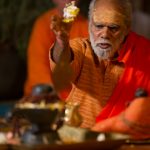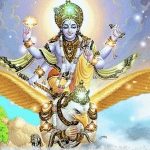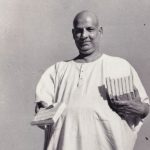 Karma, Unity and Freedom
Karma, Unity and Freedom
Yoga and the Quest for Happiness
by Srinivasan
Man wants happiness. He shuns pain. He moves heaven and earth to get the happiness he wants from sensual objects, and lo, gets himself entangled in the extricable meshes of Maya. Poor man! – Swami Sivananda
 Everyone is seeking happiness. Everyone has their own personal strategies for attaining happiness. Everyone relates to the world based on what they believe consciously or unconsciously to bring happiness or unhappiness. The drama of life is thus comprised of karma, actions to attain happiness and avoid pain, as well as reactions to the expected and unexpected consequences of actions.
Everyone is seeking happiness. Everyone has their own personal strategies for attaining happiness. Everyone relates to the world based on what they believe consciously or unconsciously to bring happiness or unhappiness. The drama of life is thus comprised of karma, actions to attain happiness and avoid pain, as well as reactions to the expected and unexpected consequences of actions.
When people act selfishly, or unskillfully, suffering is the undesired result. Promising a release from the world of suffering, yoga practice cultivates skillful strategies and attitudes to realize absolute and universal happiness. These strategies begin with healthy living and healthy relationships, with the goal of Self-knowledge— the realization of Absolute Unity within the world of apparent diversity—and Absolute Freedom from countless superimposed conditions on happiness.
Yoga focuses on the removal of the self-imposed obstacles to a natural state of happiness rather than selfishly trying to attain possessions, prestige, power or pleasure in opposition to others and conditioned in time, space and causation.
Karma, the law of action and reaction, is the feedback mechanism which yoga practitioners rely on to sharpening and eliminating the cause of suffering as the kleshas: ignorance, vanity, desires, prejudice and fear. Once recognized, the kleshas can be systematically let go of as unhealthy habits and stress.
The Three Types of Mind
It is helpful in the process of recognizing the healthy and dysfunctional approaches to happiness to understand the energetic nature of the mind. Sattva, rajas and tamas are the three qualities or gunas that motivate all action and inaction. With a pure, sattvic mind we seek happiness in Unity, as love for love’s sake; as an uncompromised commitment to Truth. The rajasic mind, motivated by selfish desires, pits each selfish individual against a world of perceived competitors, disrupting healthy relationships and Unity.
The attachments created by selfish desires condition happiness, compromising integrity, truth and freedom. The resulting suffering generates more karma. Happiness has been alienated into external objects and conditions. The tamasic mind is a state of negativity and depression resulting from the failure of selfish rajasic strategies for happiness.
- Book I 2 yogas chitta vritti nirodhah
Yoga is restraining the mind-stuff (chitta) from taking various thought forms (vrttis). - Book II 3 avidya asmita raga dvesha abhinivesha klesha
The pain-bearing obstructions (kleshas) are ignorance, egoism, attachment, aversion and clinging to life. Ignorance is the root cause of all the kleshas. - Book II 12 klesha moolah karmashaya drishta adrishta janma vedaniya
The individual collection of works (sanchita karma) has its root in these pain-bearing obstructions (kleshas), and their experience (prarabdha karma) in this or in future lives. - Book II 16 heyam duhkham anagatam
The misery which has not yet manifested is to be avoided (agami karma). - Book IV 7 karma shukla krishnam yoginah trividham itaresham
Works are neither black nor white for the Yogis; for others they are threefold, black, white, and mixed.* - Book IV 28 prasankhyanepyakusidasy sarvathavivekakhyater dharma megha samadhih
Even when arriving at the right discriminating knowledge, he who gives up the fruits, unto him comes as the result of perfect discrimi- nation, the Samadhi called the cloud of virtue. - Book IV 29 tatah kleshakarmanivrittih
From that comes cessation of pains (klesha) and works (karma).
*When the Yogi has purified the mind of the kleshas, the actions, and the karma produced by those actions will not bind him, because he did not desire them. He just works on: he works to do good, and he does good, but does not care for the result. But for ordinary people, who have not attained to that highest state, works are of three kinds, black (evil actions), white (good actions) and mixed.
their discriminative skills to choose happiness over suffering in life. Karma motivates spiritual transformation through the pain and suffering experienced when ignorant or dysfunctional strategies ultimately fail either resulting in frustrated desires or the loss of pleasure. The ignorant assumption that happiness can be attained by fulfilling the material conditions supportive of our vanity, desires, prejudices and fears, is the disease behind our suffering rather than the remedy.
Individual karma is experienced as the daily drama of reacting to the superimposed obstacles to happiness. Happiness is experienced as an illusive, impermanent prize to be conquered, captured and protected. Yoga rejects this material, conditional approach to happiness, as ignorance. The very suffering that motivates selfish action is actually the result of selfish action. Thus ignorance perpetuates suffering creating the wheel of karma. With the yogic practices of viveka (discrimination) and vairagya (dispassion), the karmic disease of perpetual suffering is treated by nam-
When material attachments are ultimately frustrated in achanging world, one’s attitude can either shift to negativ- ity and a feeling that the world is evil or unfair (the tama- sic mind), or turn to yoga, (the sattvic mind). Initially yoga allies the rajasic mind’s desire to escape suffering with the sattvic discriminative mind to work hard to develop the necessary skills to awaken Self-knowledge.
Through yoga sadhana, the aspirant cultivates healthy actions and attitudes and transforms bad habits into good ones. For the yoga practitioner, Patanjali’s Yoga Sutras serves as a manual for understanding the defects of the mind and transforming those defects into freedom enhancing virtues. Yoga cultivates the sattvic mind by removing the attachments and expectations that place conditions on happiness, and by celebrating unconditional happiness as the very essence of Life. The sattvic mind finds peace and silence. Yoga proposes that happiness and freedom are only accessible to a quiet mind. With a quiet mind one can know the Self.
Samskaras and Vasanas
The Unconscious Roots of Karma
An individual’s ego is made up of an endless collection of unconscious prejudices and habitual reactions to the material world. On the basis of these attachments, the ego objectifies the world and generates the drama we ex- perience as karma. These unconscious impressions frame how each person experiences and reacts to the conditions of their life. These experiences can be best understood according to the three types of karma.
Sanchita karma is the collection of all of the accumulated unconscious impressions and the habitual reactions to perceived objects and phenomena. Prarabdha karma is experienced as specific conditions and situations encountered throughout a lifetime, along with the pleasure and pain associated with those experiences. Prarabdha also includes the resources available during a lifetime with which to react to pleas- ant and unpleasant situations. Agami karma refers to the specific actions performed in real time in response to the prarabdha situations encountered.
The kleshas define the dysfunctional strategies for dealing with the suffering as- sociated with the vasanas (seed desires). Samskaras are the impressions created by emotional reactions to the objects of the world; and the habitual actions – physical, ver- bal and mental, triggered by those emotional reactions. Samskaras live in each person’s mental world triggering karma. One’s perceptions of the world and the reactions to those perceptions constantly leave new samskaras on the mind.
The more passionately and consistently those perceptions and reactions are repeated, the deeper the samskara. Our dream world is created from those impressions, and we consistently ‘dream’ our waking world based on the kleshas that generate our dreams. Sams- karas are unconscious memories colored by likes and dislikes. The more they are repeated, the more they take on a life of their own as vasanas, binding a person to the objects that they have come to habitually believe to be sources of happiness.
Vasanas are the unconscious buttons of temptations and infatuations with objects, as well as prejudicial dislike for objects. These objecti- fications fragment life into countless pieces of likes and dislikes, which in turn become the conditions we place on happiness. Vasanas empowered by desire, generate thoughts, (vrittis). Thoughts can only be quieted tem- porarily until the source vasanas are rooted out. Every vritti is a ‘whirlpool of energy’ that creates noise in the mind. The reactions to specific conditions experienced is the real karma, and not the actual situations or objects themselves.
Thus different people react in radically different ways to objectively comparable situations. One per- son’s trauma is another person’s heroic opportunity. One person’s obsession or addiction, appears repulsive to an- other. The practice of yoga quiets the mind of the noise produced from vrittis and their root klesha vasanas. By burning the vasanas through Self-knowledge, devotion and meditation, remembering the sacred, all-pervading nature of God or Self, one discovers freedom from the wheel of karma.
Karma and Vasanas
Discrimination and Imagination
As vasanas are the very essence of desire, they are based in imagination. Karma operates in the waking world of prarabdha by natural laws of cause and effect shared by all sentient beings. Whether dreaming or waking, vasana is the emotional response of like or dislike to the per- ceived objects and conditions of the world. Through discrimination, one learns from the reactions to actions and attitudes what promotes health, prosperity and wisdom, becoming more skillful in one’s strategies for happiness.
This yoga of karma is ‘skill in action’. When one turns the motivation from seeking pleasure based in imagination to acting for the universal good, happiness is derived through living dharma. Peace of mind, compassion, and realizing the unity in diversity become the sattvic results of dharmic action, as opposed to the suffering ultimately resulting from the rajasic and tamasic strategies of ob- jectifying the world into the pleasant and unpleasant.
The Three Gunas and Karma
The mind is sattvic, rajasic, or tamasic according to the predominant nature of the vasanas and samskaras. The nature of the samskara is based on the quality of the vasana that generated the specific reaction to an object or experience. If we have fear or hatred towards a certain object the habitual reaction is already programmed. Thus samskaras and vasanas are inseparable. Every ‘new’ ex- perience is informed from past experiences, and most often the ‘new experience’ only reinforces past impres- sions and the seed emotional reactions.
Through repetition vasanas increase in strength. A dark hatred or addiction is maintained by tamasic samskaras and vasanas. A passionate desire or prejudice corresponds to rajasic samskaras and vasanas. Passionate vasanas can rotate from love to hatred and back (“I love you honey”, and “go to hell honey”). A sattvic samskara reflects a clear knowledge of unity, compassion and love, and a deep understanding and commitment to dharma. Through discrimination we learn from karma.
The knowledge gained creates new skillful sattvic samskaras and vasanas. Sadhana is conscious practice to eliminate the tamasic, and transform the rajasic into sattvic samskara/vasanas of devotion to God and dharma, and knowledge of the unchanging reality. Sattvic samskaras ultimately serve as a clear mirror to reflect the unconditioned, immortal Self. The end of karma is Self-knowledge, freedom from all vasanas. Ultimately, through the practice of medita- tion and discrimination, samskaras of restraint bring the mind to experience greater and greater depths of silence and meditation.
Sadhana to Transform and Burn Karma
Yoga sadhana systematically transforms the darkness and agitation of the tamasic and rajasic vasanas into sattva—eventually burning even the sattvic vasanas in the realization of the Self. Each path of yoga offers its own sadhana for liberation:
Karma Yoga – through the power of selfless actions motivated by caring and compassion, vanity and selfish attachment are transformed into a life of loving integrity, and a realization of unity and grace.
Bhakti Yoga – transforms vasanas generated by despair, fear, vanity, craving, anger, jealousy and attachment into devotion. Resting in supreme love of God, bhakti devel- ops faith through concentration on the sacred, and will- ingly surrenders ego as a celebration of infinite grace. Through love of God, one becomes God-like culminating in knowledge of the universal Self in all.
Raja Yoga – uses pratipaksha bhavana, (replacing self- ish rajasic and negative tamasic habits with pure sattvic ones ) and meditation as paths to freedom from karma. The light of intuition burns the ignorance of the vasanas and the sacred unity of life is no longer fragmented into objects of desire, attachment and repulsion. Renunciation of vasanas is developed first by pratipaksha bhavana and then through the intuitive knowledge gained. A mind ha- bituated to peace, knowledge and joy through the prac- tice of meditation can choose peace when aggravated rajasic and tamasic vrittis actively arise. Awareness of the unchanging Self or purusha is awakened replacing all previous samskaras.
Jnana Yoga – Knowledge is the means for Self-realiza- tion and the cure for the disease of ignorance. Knowledge of God or the Absolute leads to devotion, selfless service, and meditation on the Absolute as the Consciousness animating all life.
How Does Karma Work?
The most important factor in the generation of karma is intention. When two people do a similar action with different intention, the effect of the action (karma phala) will be different. If someone tries to help another but ends up hurting them, the intention to help creates good karma generating unity and freedom. However, any ele- ment of carelessness or disrespect in the action, gener- ates negative karma reinforcing ignorance.
It is important to note that what we consider ‘good’ or ‘bad’ karma depends on the guna that motivates and informs both the action, the intention, and the consequences of the action. When the mind is predominately sattvic, an unpleasant situation can be seen as a positive learning experience, or as a requirement for strengthening of character and integrity; whereas a pleasant situ- ation could be seen as a temptation, a compromise or distraction from one’s spiritual discipline and principles.
For a rajasic practitioner, a psychic power might be seen as a deserved reward for hard work invested in sadhana, to be exploited to the maximum extent. To a sattvic aspirant, that same power will be seen as a tempting by-product of tapas, to be renounced as an obstacle to the goal of liberation and Self-realization. To a tamasic person, there is no point to practice, being oblivious to the many gifts at their disposal.
The law of karma motivates the burning desire for liberation necessary for spiritual transformation. From the perspective of the law of karma, all actions have con- sequences and all experiences are the consequence of past actions. Taking responsibility for karma, one looks to become more skillful and success suddenly becomes possible. True unity is reflected in a compassionate outlook towards the challenges of others.
“There, but for the grace of God go I”; to love thy neighbor as thyself, are not just moral injunctions, but attitudes supported by the law of karma, precepts for daily practice. To per- ceive others as spiritual inferiors is a sign of a rajasic ego obstructing the realization of unity and honoring life as sacred. The lives of the saints of all traditions have set examples for a life of compassion and unity.
Yoga shows the way.
Srinivasan, Yoga Acharya for US East Coast and Chicago and senior disciple of Swami Vishnudevananda, teaches throughout the Sivananda organisation in North America and Teachers’ Training Courses worldwide.































